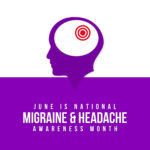National Congenital Cytomegalovirus Awareness Month is observed annually in June to increase awareness about congenital cytomegalovirus among pregnant women, parents, and healthcare providers, and to counsel them on the virus’s effect on children. Did you know that Congress designated June as National Congenital Cytomegalovirus Awareness Month in 2011? Cytomegalovirus is a common virus that can infect anyone. It does not show any visible signs or symptoms in healthy people, and infected people may not even know they have the virus. The virus can have severe consequences for infants who are infected before birth. Pregnant women can transfer the condition to their babies, leading to congenital disabilities, hearing loss, and developmental delay.
History of CMV Awareness Month
The origins of newborn screening can be traced to the 1950s and 1960s when Robert Guthrie pioneered a blood test (bacterial inhibition assay) to screen for phenylketonuria in newborn babies on the second day of life. In 1962, using funds from the Child Health Bureau, Guthrie began a pilot study in 29 states of the United States, enrolling 400,000 newborns. Because of the success of this study, many states began adopting newborn screening. By 1965, newborn screening for phenylketonuria had become mandatory in 27 states, with others giving public health departments the power to decide. In the 1970s, the testing for congenital hypothyroidism was included in newborn screening.
In the early 1990s, scientists introduced tandem mass spectrometry as more effective equipment for newborn screening. While as affordable as Guthrie’s bacterial inhibition assay, tandem mass spectrometry detected more disorders than previous techniques using a single drop of blood. The introduction of tandem mass spectrometry allowed an expansion in the number of disorders screened in various states. Over time, the technology began replacing Guthrie’s bacterial inhibition assay as the primary technique for newborn screening. However, the filter paper developed by Guthrie is still used today across the globe.
In March 2005, the American College of Medical Genetics released a report recommending that all states screen infants for 29 specific disorders — mainly using tandem mass spectrometry. On April 24, 2008, the administration of President George W. Bush introduced the Newborn Screening Saves Lives Act of 2007. This act aimed to increase the awareness of screening newborns to identify specific disorders. In 2011, Congress passed a resolution, designating June as National Congenital Cytomegalovirus Awareness Month.
CMV Awareness Month timeline
Robert Guthrie screens 400,000 babies across 27 states for newborn disorders.
Scientists introduce tandem mass spectrometry to detect more disorders than previous techniques.
The American College of Medical Genetics recommends that all states screen for 29 specific disorders.
Congress passes the resolution to designate June as National Congenital Cytomegalovirus Awareness Month.
CMV Awareness Month FAQs
What trimester is associated with the highest risk?
Pregnant women in their third trimester are at the highest risk of transmitting the cytomegalovirus to their unborn babies.
How many people know about cytomegalovirus?
According to statistics, only 9% of women in the United States know about the virus.
How do you prevent your babies from getting cytomegalovirus?
You can reduce the risk of your baby getting infected by practicing good personal hygiene during and after pregnancy, and by testing for the virus.
How to Observe CMV Awareness Month
Share information about congenital cytomegalovirus
Sharing information is one of the easiest ways to make the most impact during National Congenital Cytomegalovirus Awareness Month. You can share anything from details about the virus and facts, to signs, symptoms, and how to prevent transmitting it to unborn infants and children. Share the information on your social media pages, with colleagues at your workplace, or over coffee with friends and acquaintances.
Donate to charity
Another way to make the most impact is to donate to foundations and not-for-profit organizations focusing on congenital cytomegalovirus. By doing so, you can contribute to vaccine development, increase awareness and reduce the effects of the virus. One of such organizations you can donate to is the National CMV Foundation.
Organize an awareness program
If you are already a member of a C.M.V. organization or a health practitioner, you can organize activities or events during National Congenital Cytomegalovirus Awareness Month to increase your impact. These could be public health forums, educational programs, or community outreach.
5 Worrying Facts About Cytomegalovirus
There is no vaccine
There is no vaccine to protect against cytomegalovirus.
It is widespread in the United States
One in 150 newborns has a cytomegalovirus infection.
It causes infant hearing loss
Congenital cytomegalovirus is the leading cause of non-genetic hearing loss in babies.
It has possible life-long consequences
One in every five babies who do not show congenital cytomegalovirus signs suffers long-term health consequences.
It’s the most transmitted virus to newborns
Cytomegalovirus is the most common virus transmitted from pregnant women to unborn children.
Why CMV Awareness Month is Important
It reduces the transmission to unborn babies
National Congenital Cytomegalovirus Awareness Month focuses on raising awareness and educating people about congenital cytomegalovirus. It gives pregnant women the opportunity to learn the importance of prenatal screening and the necessary steps they need to take to prevent transmitting the virus to their babies. Healthcare providers also learn about the disease, its symptoms, and how to educate their pregnant patients.
It allows for early detection
According to statistics, only 9% of women know about congenital cytomegalovirus. That means, by the time they detect the virus, it might already be too late for their babies. National Congenital Cytomegalovirus Awareness Month not only spreads awareness about the virus; it also educates and encourages pregnant women and parents on early screening for early detection.
It minimizes the impact
During National Congenital Cytomegalovirus Awareness Month, parents also learn the signs and symptoms of congenital cytomegalovirus. That knowledge helps parents and expecting mothers know what to look out for, and enables them to take the necessary action to mitigate the effect of the virus if detected in their infant.
CMV Awareness Month dates
| Year | Date | Day |
|---|---|---|
| 2026 | June 1 | Monday |
| 2027 | June 1 | Tuesday |
| 2028 | June 1 | Thursday |
| 2029 | June 1 | Friday |
| 2030 | June 1 | Saturday |
















































































































